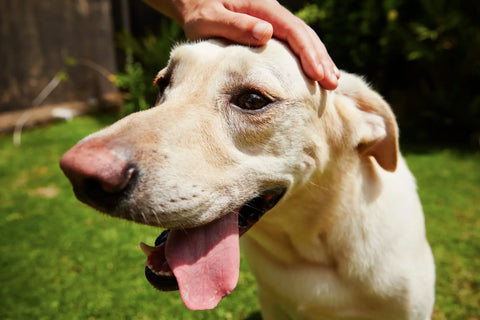Summer can be a difficult time for our four-legged friends. Although they might love the long walks nice weather brings, if it gets too hot, things can quickly turn sour. Unlike humans, dogs don’t have the ability to sweat and cool themselves down by panting. This, coupled with their fur, can make them prone to overheating. What’s more, when the sun is really shining, the ground can quickly become too hot for their paws and lead to serious burns.
Most owners understand that dogs can be sensitive to heat. So, when the mercury rises, what can you do to keep your dog healthy and happy?
Identifying heatstroke in dogs
One of the most important things you can do to keep your dog safe in the summer is to teach yourself the symptoms of heatstroke.
Heatstroke means your dog stops being able to regulate its own internal temperature because it’s just too hot. This rapid increase in body temperature can quickly lead to exhaustion and even organ failure if not treated swiftly. Humans can suffer from heatstroke too, but it’s often far more serious in dogs.
In 2016, there were 395 confirmed cases of heat-related illness in dogs in the UK, out of 905,000 dogs under primary veterinary care. Although around 1 in 7 dogs treated for heatstroke sadly doesn’t make it, 98% of dogs that are treated after showing mild symptoms survive. Nonetheless, owners should be vigilant.

There are a few telltale signs that your dog might be suffering from heatstroke, according to the PDSA.
Excessive panting
Lying down a lot or struggling to stand up
Dribbling and drooling excessively, or foaming at the mouth
Bright red gums
Confusion
Diarrhoea
Vomiting
If your dog starts showing any of the above symptoms, you need to call your vet immediately. You should also move them into a shady spot, give them small amounts of water to drink, and pour room-temperature water over their fur.
Never use very cold or ice water, as this can shock them and make the problem worse.
Your vet can give you the right advice for your situation and hopefully help you treat your dog before the condition gets too serious. However, as with most illnesses, prevention is far better than treatment. When it gets hot, owners need to ensure they’re doing all they can to keep their pup safe and well.

Preventing heatstroke in dogs
Some breeds are more susceptible to heatstroke and heat-related illness, such as Chow Chows, Bulldogs and French Bulldogs. Large breeds or dogs which are overweight can also potentially be more prone to heatstroke. Heatstroke can strike at any time of year, not just in the summer. Dogs are generally comfortable between 15-25°C but this can depend on a number of factors, including breed, coat, and fitness levels.
Generally, as long as your dog is fit and healthy, and is not a breed of concern, they should be absolutely fine for most of the year. However, when the temperature skyrockets, you should take action to keep them cool.The best thing you can do for your dog when it gets hot is keeping them in a nice, cool, shaded area with plenty of water to drink. Beyond this, there are a few other things you can do to keep your pup safe in the heat.
Restrict walks to very early in the morning or late at night when it is cool. Don’t run or cycle with them in the hotter months. If necessary, skip walkies for a day: no dog ever suffered from missing one walk.
Test the pavement with the back of your hand before you head out for walks. If it’s uncomfortable for you, it’s too hot for Max.
Use sprinklers, hoses, and even paddling pools as a fun way to keep your dog cool. Some dogs love to go fishing for treats or vegetables!
If your dog has a thick or long coat, consider giving them a ‘puppy cut’ in the summer months. Shorter hair means less trapped heat and a cooler dog. If you have a double-coated dog, such as a Husky, and can’t cut their fur short, ensure you groom and brush them regularly to keep their coat thin and free of matting and allow cool air to reach their skin


Crucially, never leave your dog in the car. Dogs die in hot cars, even if the temperature is relatively low outside. Studies have shown that if the temperature outside the car is around 22°C, the temperature inside can rocket to a shocking 47°C in a matter of minutes. That’s just 9°C shy of the hottest air temperature ever recorded on earth! The same goes for conservatories and outbuildings.
Feeding dogs in the summer
Although you might not know it, the way your dog eats during the hotter months can be an indicator of their health and wellbeing.
You might notice that your dog’s appetite dips on very hot days. This doesn’t necessarily mean they are ill. Dogs will eat more or less based on their energy levels, so when it is hot and their energy is low, their appetite drops too. If they are moving less - as we all generally do in the hotter months - then they need less fuel. It’s worth keeping in mind, however, that while eating less is normal, not eating at all is not. If your dog has stopped eating entirely, you should speak to your vet.
There are a few things you can do feeding-wise to keep your dog more comfortable in summer: Try to be in tune with your dog’s appetite level: decrease or increase portions as needed. Don’t be afraid to reduce from two meals a day to one for a short while. Serve food at room temperature. Feed your dog in a cool, shaded place. Avoid feeding after a walk or playtime when they will be hotter. Keep plenty of cold water on hand to keep them hydrated.
What should I feed my dog in summer?
You should make sure the food you are feeding your dog is packed full of the right nutrients. Cheaper, mass-produced dog foods often include a lot of ‘filler’ of low nutritional value. Dogs need a good, healthy balance of proteins, fats, vitamins, minerals, and vegetables to keep their energy levels up, especially when it’s hot outside.
Percuro is a fantastic option for owners looking for nutritionally balanced dog food with everything their dog needs. If you’re looking to switch up your dog’s food, find out more here, or visit our shop page.
Be vigilant
Overall, while dogs do struggle in summer, being an attentive owner is all you really need to do to ensure your pup is happy and healthy in the sun.
If you have any concerns, you should always go straight to your vet for advice, but by keeping your pup hydrated, minimising time in direct sunlight, and being careful when it comes to playtime, there’s no reason why your dog can’t enjoy summer too.

















